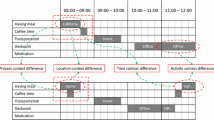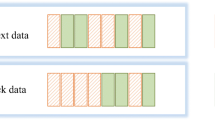Abstract
To measure the similarity of contexts in smart devices, comparison is made of the user-defined contexts and another context which is defined in a server or in a network device that a user has (Segev and Toch IEEE Trans Serv Comput 2(3):210–222, 2009). While it processes to compare, if they find some users who have similarities with them, they surely may be interested in the users, because they know that they can share their information without the time wasting to search, finally getting what they want. However, according to the characteristics of the registered contexts, they are classified into two types, a rank-definitional context and a rank-undefined context. Also, the users usually want to use the two types to get quickly what they want at the same time. It means that another algorithm may be needed to get the similarity depending on the contexts, because the existing similarity search algorithms usually perform the similarity process without the contexts’ characteristics analysis. They assume that all contexts have the same features when they process. Now, the existing methods that find the similarity usually have an accuracy problem. Low accuracy gives invisible services to users. This paper has suggested named context-based pattern measurement method including weight defines for higher accuracy. As a result, it would be able to get accuracy similarity by applying to the proposed algorithms about 69.072 % without weight and also 95.322 % accuracy in case it has a specific weight.






Similar content being viewed by others
Explore related subjects
Discover the latest articles, news and stories from top researchers in related subjects.References
Bassoli A, Brewer J, Dourish P, Martin K, Mainwaring S (2007) Underground aesthetics rethinking urban computing. Pervasive Comput 6(3):39–45
Bruzzone L, Carlin L (2006) A multilevel context-based system for classification of very high spatial resolution images. Geosci Remote Sens IEEE Trans 44(9):2587–2600
Kardi T (2008) Similarity measurement. http://people.revoledu.com/karditutorial/Similarity/
Ko H, Marreiros G, An K, Vale Z, Kim T, Choi J (2012) A study on dynamic state information (DSI) around users for safe urban life. Comput Math Appl 63(2):554–563
Ko S, Kim D-W (2014) An efficient node ordering method using the conditional frequency for the K2 algorithm. Pattern Recognit Lett 40:80–87
Kumar J, Ye P, Doermann D (2014) Structural similarity for document image classification and retrieval. Pattern Recognit Lett 43:119–126
Mokhtari M, Ghorbel M, Kadouche R, Feki MA (2004) From smart home to smart space in independent living: a framework for multiple contexts management. In: Third IEEE international conference on wireless and mobile computing, networking and communications, pp 74–80
Ogiela L (2013) Semantic analysis and biological modelling in selected classes of cognitive information systems. Math Comput Model 58(5–6):1405–1414
Ogiela L, Ogiela MR (2011) Semantic analysis processes in advanced pattern understanding systems. In: Kim TH, Adeli H, Robles RJ et al (Eds) Conference: 3rd international conference on advanced science and technology (AST’11) location: Jeju Island, South Korea Date: Jun 15–17, 2011. Advanced computer science and information technology. Book Series: communications in computer and information science, vol 195, pp 26–30
Segev A, Toch E (2009) Context-based matching and ranking of web services for composition. IEEE Trans Serv Comput 2(3):210–222
Sun S, Yan C, Feng J (2012) Analysis of influence for social engineering in information security grade test. In: 2012 International conference on computer science and electronics engineering (ICCSEE), vol 2, pp 282–284
Torres GJ, Basnet RB, Sung AH, Mukkamala S, Bernardete MR (2008) A similarity measure for clustering and its applications. Proc World Acad Sci Eng Technol 490–496
Wai YL, Lau FCM (2002) A context-aware decision engine for content adaptation. Pervasive Comput IEEE 1(3):41–49
Yoneki E (2005) Evolution of ubiquitous computing with sensor networks in urban environments. In: Ubiquitous computing conference, metapolis and urban life workshop proceedings, pp 56–59
Zou J, Liu C-C, Zhang Y, Lu G-F (2013) Object recognition using Gabor co-occurrence similarity. Pattern Recognit 46(1):434–448
Author information
Authors and Affiliations
Corresponding author
Additional information
Communicated by V. Loia.
Rights and permissions
About this article
Cite this article
Ko, H., Bae, K., Choi, J. et al. Similarity recognition using context-based pattern for cyber-society. Soft Comput 20, 4565–4573 (2016). https://doi.org/10.1007/s00500-015-1763-9
Published:
Issue Date:
DOI: https://doi.org/10.1007/s00500-015-1763-9




